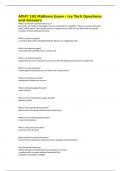Exam (elaborations)
APHY 102 Midterm Exam - Ivy Tech Questions and Answers
- Course
- Institution
APHY 102 Midterm Exam - Ivy Tech Questions and Answers What is a hormone and how does it act? Hormones are chemical messengers that are responsible for regulation. They are secreted into body fluids, mainly blood. It has specific actions on target tissues, which are any tissue that has specific r...
[Show more]



